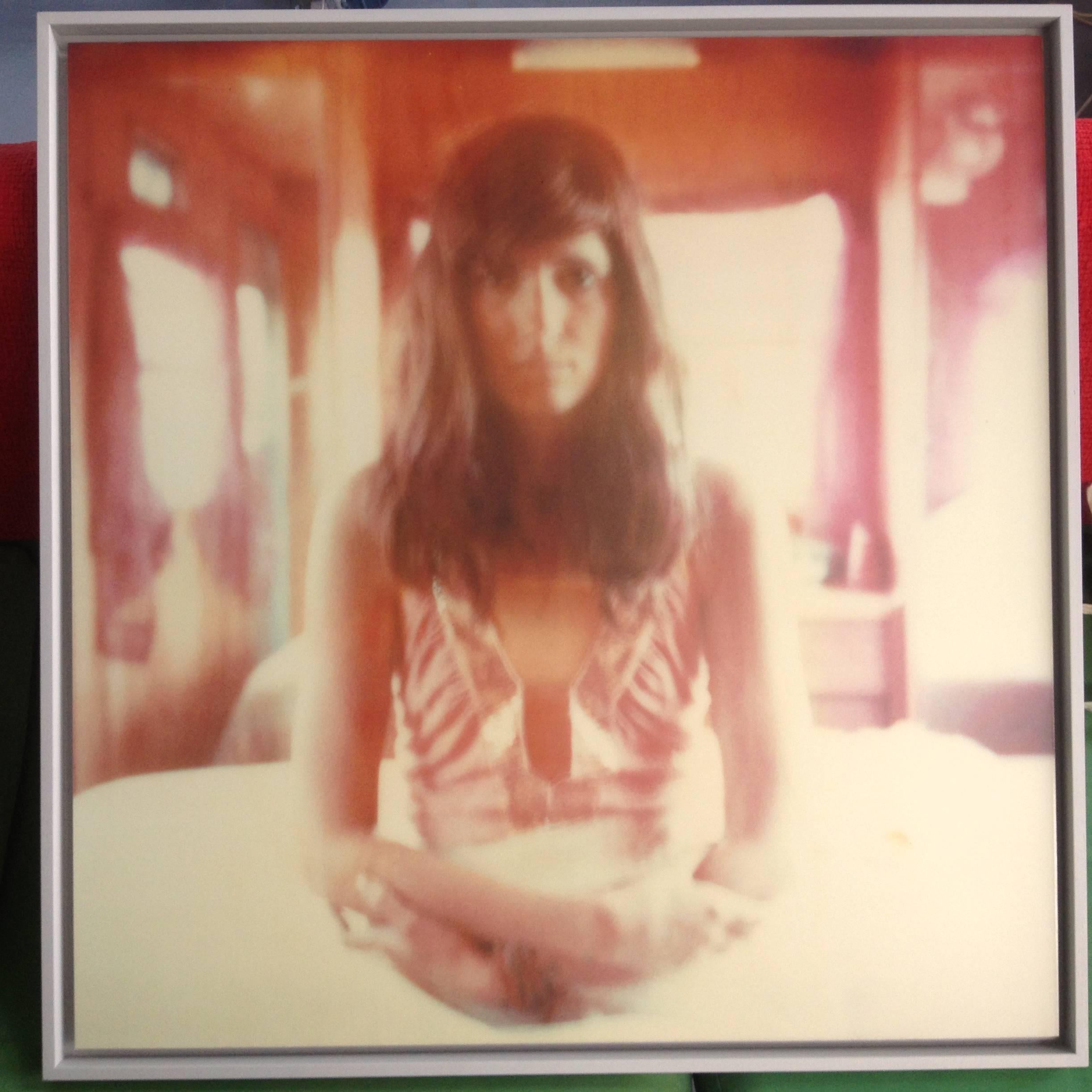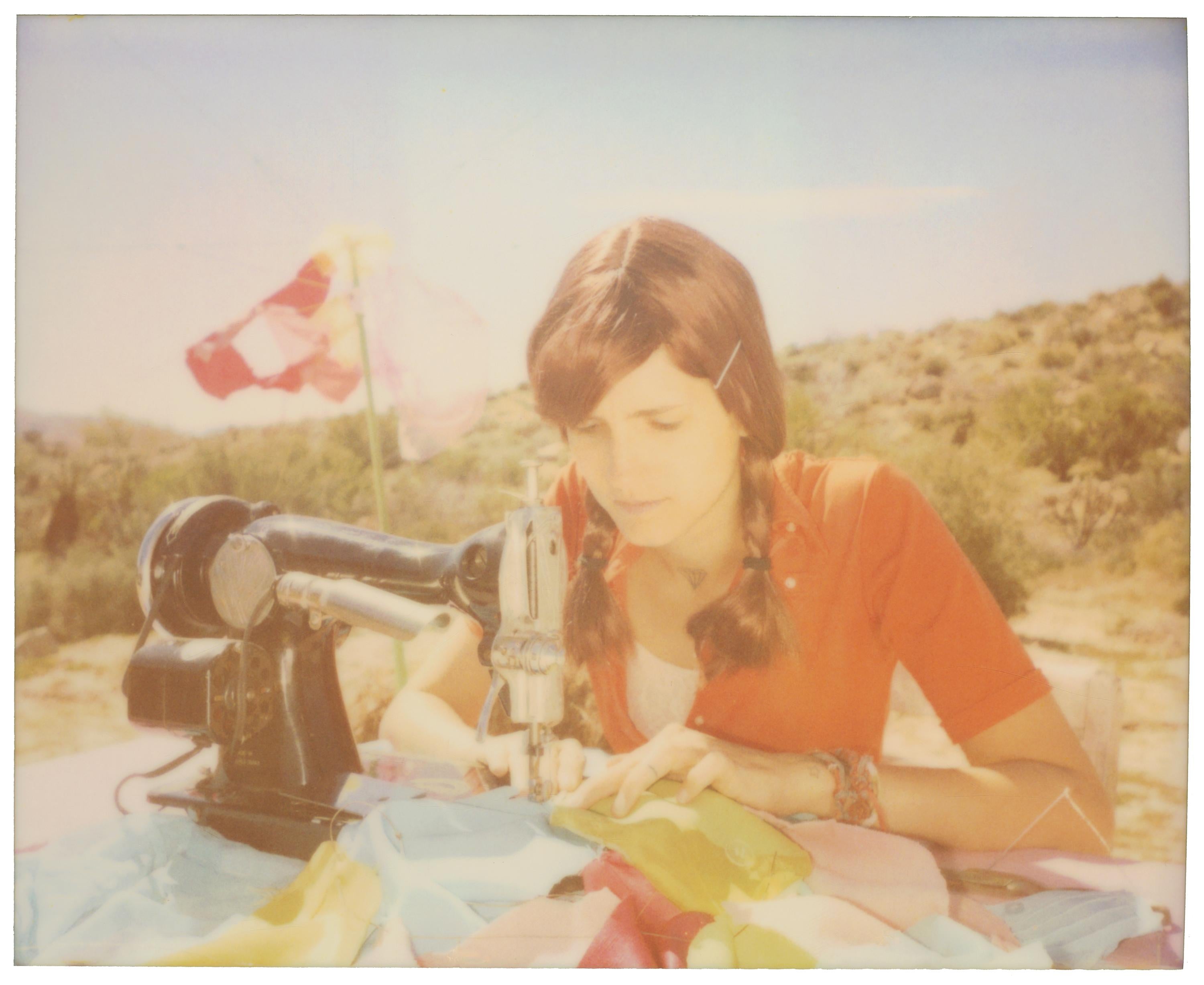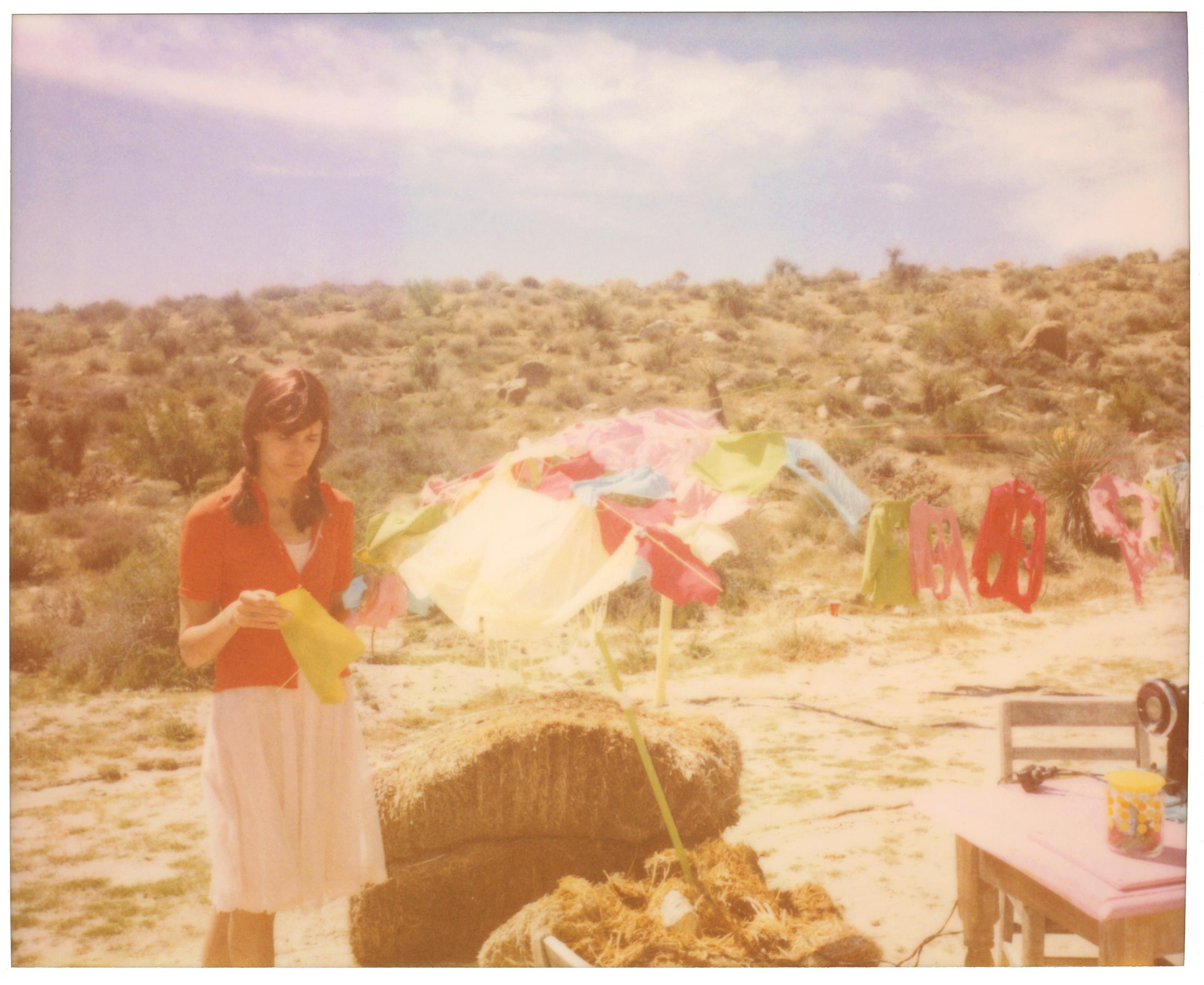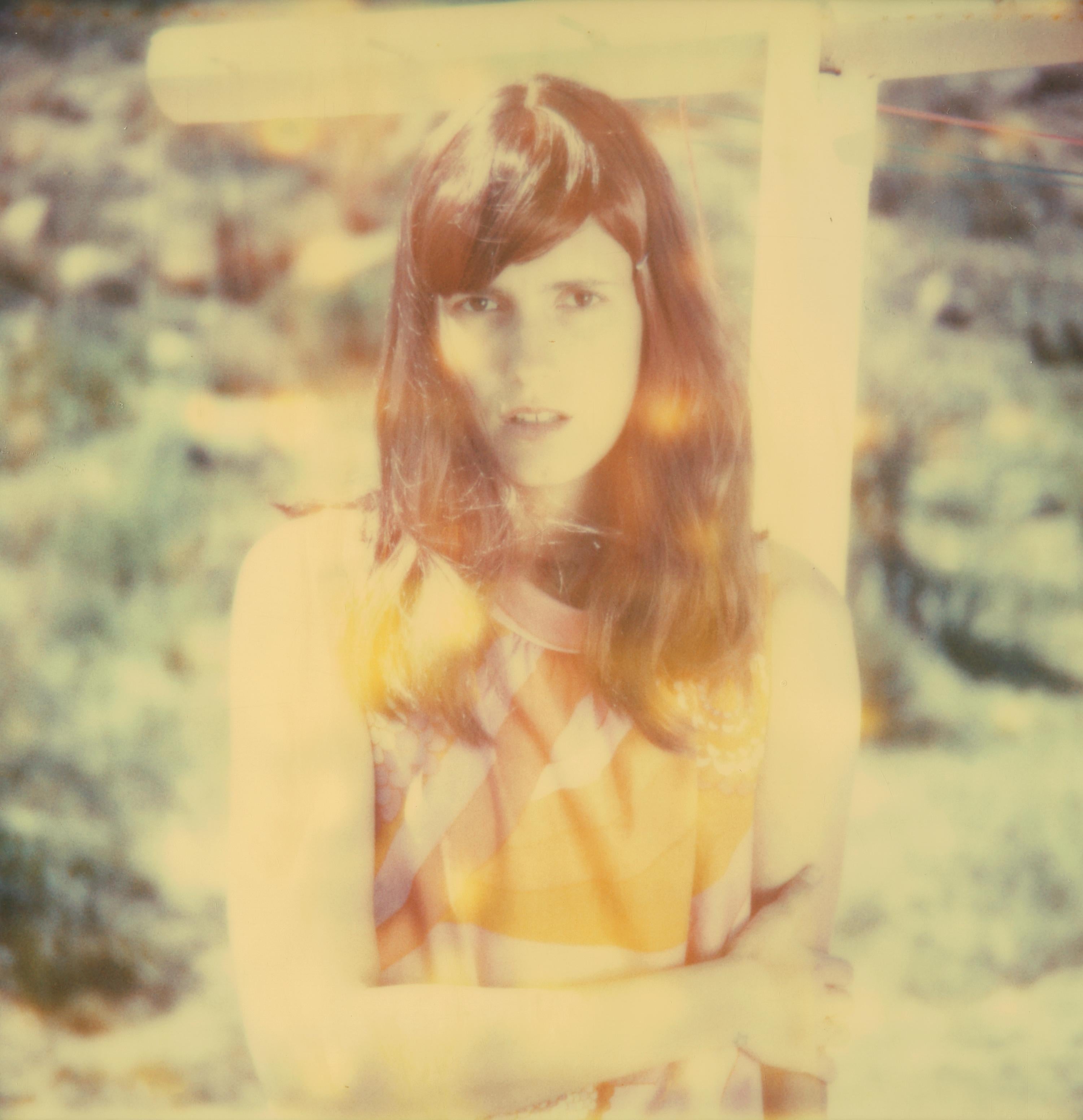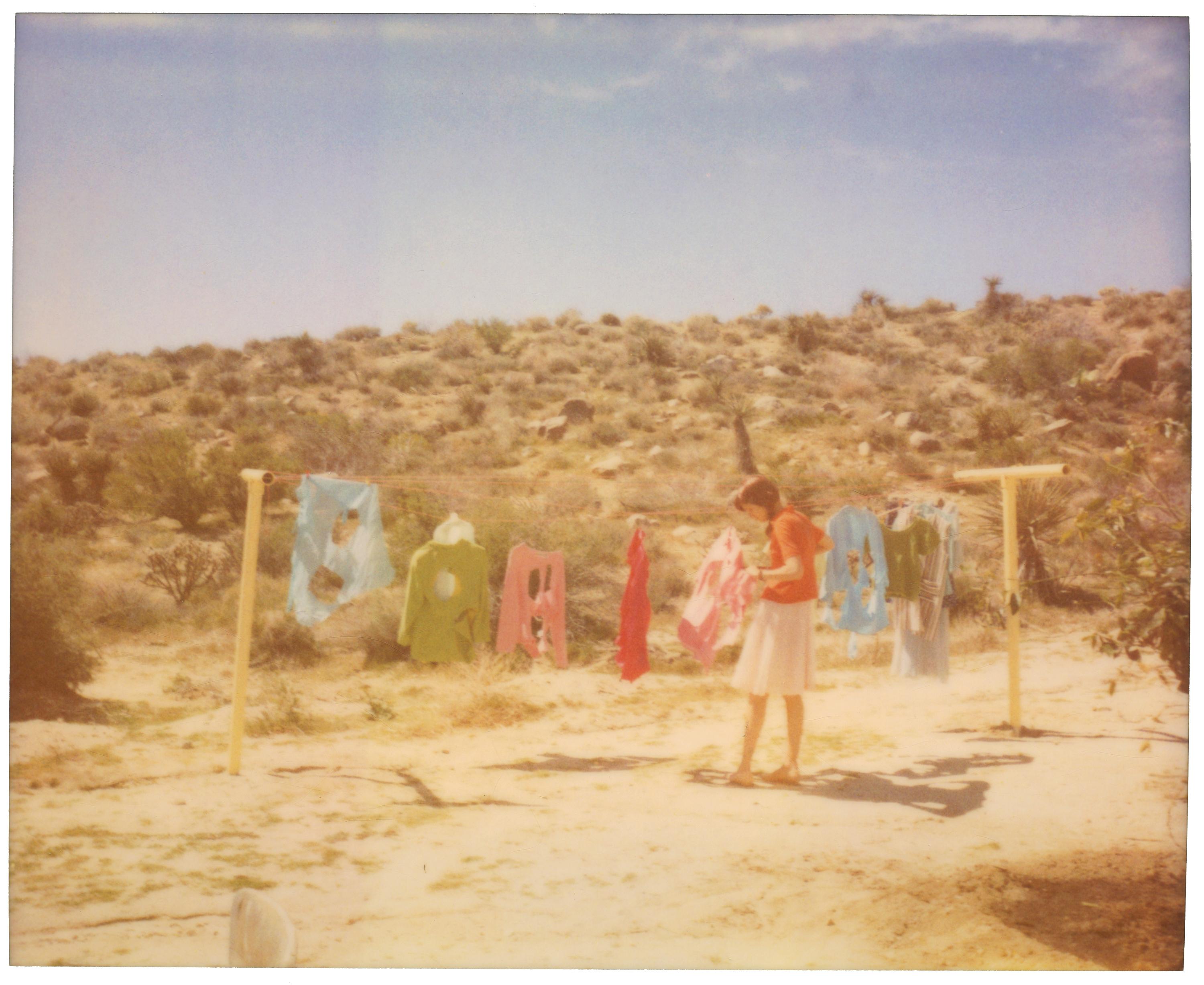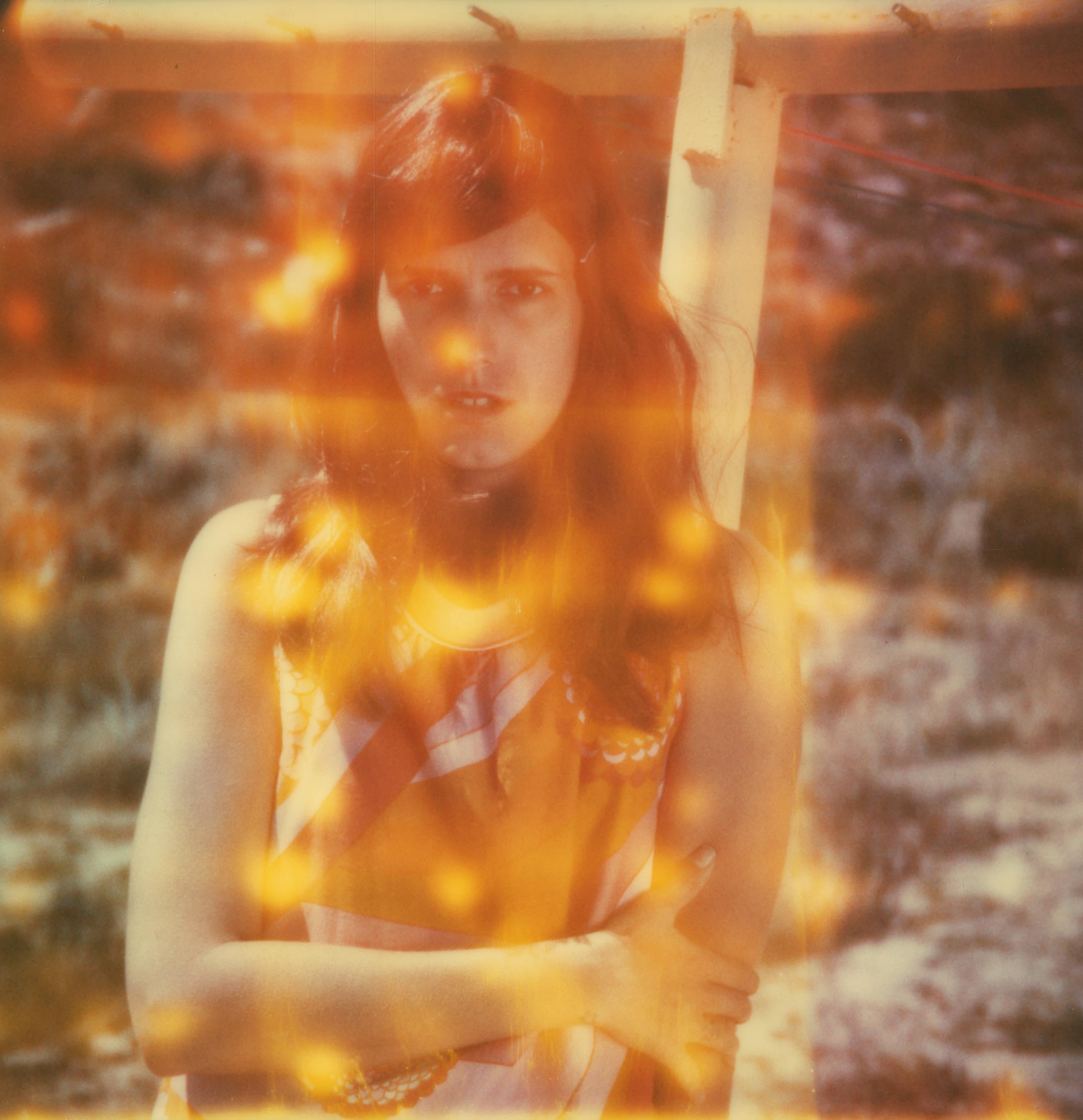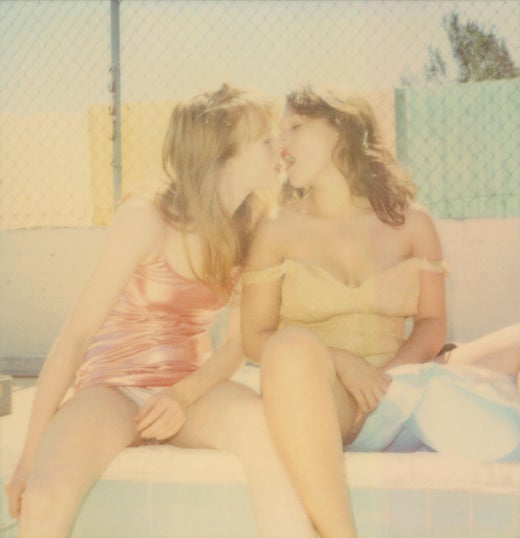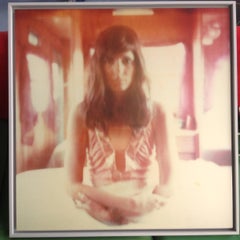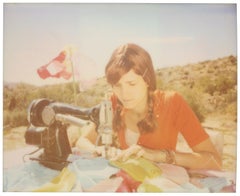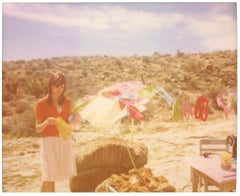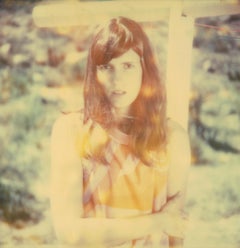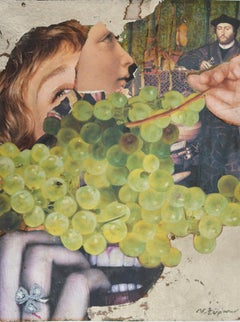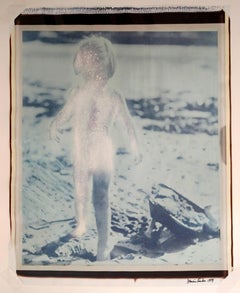Items Similar to What happened yesterday? (The Girl behind the White Picket Fence) - Polaroid
Want more images or videos?
Request additional images or videos from the seller
1 of 2
Stefanie SchneiderWhat happened yesterday? (The Girl behind the White Picket Fence) - Polaroid2006
2006
$380
£286.94
€332.90
CA$534.02
A$594.97
CHF 310.60
MX$7,223.76
NOK 3,904.09
SEK 3,690.31
DKK 2,485.09
About the Item
What happened yesterday? (The Girl behind the White Picket Fence) - 2008
20x20cm,
Edition of 10,
Archival C-Print, based on the Polaroid.
Certificate and Signature label.
Artist Inventory #16341
Not mounted.
Stefanie Schneider's scintillating situations take place in the American West. Situated on the verge of an elusive super-reality, her photographic sequences provide the ambience for loosely woven story lines and a cast of phantasmic characters.
Schneider works with chemical mutations of expired Polaroid film stock. Chemical explosions of color spreading across the surfaces undermine the photograph's commitment to reality and induce her characters into trance-like dream-scapes. Like flickering sequences of old road movies Schneider's images seem to evaporate before conclusions can be made - their ephemeral reality manifesting in subtle gestures and mysterious motives. Schneider's images refuse to succumb to reality, they keep alive the confusions of dream, desire, fact, and fiction.
She is currently working on the 29 PALMS, CA. 29 PALMS, CA is a feature film / art piece that explores and chronicles the dreams and fantasies of a group of individuals who live in a trailer community in the Californian desert. A defining feature of the film is the use of still images and the use of voice over. Characters talk to us / themselves / you about their ambitions, memories, hopes, fears and dreams. The film is to be shot using a mix of super 8 and 16mm film stock and Polaroid images. Certain computer-generated effects will also be used to enhance the films surreal mood and to animate its dark humor. Radha Mitchell, Marc Forster, Udo Kier, Max Sharam among others are participating in the project.
Stefanie Schneider received her MFA in Communication Design at the Folkwang Schule Essen, Germany. Her work has been shown at the Museum for Photography, Braunschweig, Museum für Kommunikation, Berlin, the Institute Neue Medien, Frankfurt, the Nassauischer Kunstverein, Wiesbaden, Kunstverein Bielefeld, Museum für Moderne Kunst Passau, Les Rencontres d'Arles.
- Creator:Stefanie Schneider (1968, German)
- Creation Year:2006
- Dimensions:Height: 7.88 in (20 cm)Width: 7.88 in (20 cm)Depth: 0.04 in (1 mm)
- Medium:
- Movement & Style:
- Period:
- Condition:
- Gallery Location:Morongo Valley, CA
- Reference Number:1stDibs: LU652314813742
Stefanie Schneider
Stefanie Schneider received her MFA in Communication Design at the Folkwang Schule Essen, Germany. Her work has been shown at the Museum for Photography, Braunschweig, Museum für Kommunikation, Berlin, the Institut für Neue Medien, Frankfurt, the Nassauischer Kunstverein, Wiesbaden, Kunstverein Bielefeld, Museum für Moderne Kunst Passau, Les Rencontres d'Arles, Foto -Triennale Esslingen., Bombay Beach Biennale 2018, 2019.
About the Seller
4.9
Platinum Seller
Premium sellers with a 4.7+ rating and 24-hour response times
Established in 1996
1stDibs seller since 2017
1,036 sales on 1stDibs
Typical response time: 2 hours
- ShippingRetrieving quote...Shipping from: Morongo Valley, CA
- Return Policy
Authenticity Guarantee
In the unlikely event there’s an issue with an item’s authenticity, contact us within 1 year for a full refund. DetailsMoney-Back Guarantee
If your item is not as described, is damaged in transit, or does not arrive, contact us within 7 days for a full refund. Details24-Hour Cancellation
You have a 24-hour grace period in which to reconsider your purchase, with no questions asked.Vetted Professional Sellers
Our world-class sellers must adhere to strict standards for service and quality, maintaining the integrity of our listings.Price-Match Guarantee
If you find that a seller listed the same item for a lower price elsewhere, we’ll match it.Trusted Global Delivery
Our best-in-class carrier network provides specialized shipping options worldwide, including custom delivery.More From This Seller
View AllGravity (The Girl behind the White Picket Fence) - Polaroid, Contemporary, Color
By Stefanie Schneider
Located in Morongo Valley, CA
Gravity (The Girl behind the White Picket Fence) - 2013
80x80cm,
Edition 2/5.
Analog C-Print printed on Fuji Archive Paper, hand-printed by the artist,
based on the Polaroid.
Mou...
Category
2010s Contemporary Color Photography
Materials
Wood, Archival Paper, Photographic Paper, C Print, Color, Polaroid
Rendering Memories (The Girl behind the White Picket Fence) - Polaroid, Portrait
By Stefanie Schneider
Located in Morongo Valley, CA
Rendering Memories II (The Girl Behind the White Picket Fence) - 2013
20x24cm,
Edition of 10, plus 2 Artist Proofs.
Archival C-Print, based on the original Polaroid.
Signature label and certificate.
Artist Inventory #13388.
Not mounted.
Offered is a piece from the movie: The Girl Behind the White Picket Fence. Written and directed by Stefanie Schneider
A tale told with blemished and expired Polaroid film about the hopes and dreams of a newly orphaned girl after losing her parents who lived in the Californian desert in an old travel trailer.
-filmed with Polaroid film stock and Super-8 footage, overlaid with poetic voice-over monologue - this feature film creates a dynamic kaleidoscope of words and pictures, a dreamy tale that channels Terrence Malick, Gus Van Sant, and pages torn from a lonely girl's journal.
(Palms Springs life magazine / Caroline Ryder)
Stefanie Schneider
By Caroline Ryder
Travel up a bumpy dirt road in Morongo Valley, the trail strewn with rocks, and you’ll come upon a gigantic 1950s trailer in pristine condition, ringed by a white picket fence, with cottontail rabbits hopping among neat little rose bushes that bloom in spite of the broiling desert heat.
Inside the trailer are period accents—a vintage radio, vintage fridge, little crocheted doilies, and dusty gilt-framed photographs. It’s a surreal home-sweet-home, an Americana fantasy as imagined by German artist and experimental filmmaker Stefanie Schneider whose work is so inspired by the desert landscape, she made it her home in 2005. “There’s a completely different light here than in Germany, a beautiful light,” says Schneider, whose property in Morongo is dotted with vintage trailers. They surround her midcentury home and serve as sets for her photoshoots or as guest lodgings for her friends from Hollywood and Berlin. “But what I really love about the desert is the desolation,” she continues. “The sense of hope for something that might or might not come. It’s easy to see our dreams projected in the desert.”
Famed for shooting trailer park chic fine art photographs exclusively on vintage Polaroid film, Schneider recently completed her most ambitious project to date—a feature film made entirely of Polaroid stills (4000 images in total), the story set around her magnificent 1950s trailer. The film, called “The Girl Behind The White Picket Fence” tells the story of a broken-hearted girl who lives in the trailer. Her name is Heather, and she is played by model Heather Megan Christie, girlfriend of actor Joaquin Phoenix, and former partner of Red Hot Chili Peppers singer Anthony Kiedis, with whom she has a son. Heather stars opposite Kyle Larson (who plays ‘Hank’), a real-life gypsy fisherman who catches crab in Alaska when he’s not surfing in Southern California. Neither of the two had ever acted before, and never in the history of movie-making has a director shot a film entirely on Polaroid film.
“There was great difficulty shooting a film this way,” says Schneider, who, with her long straight hair, wide innocent eyes, and thick-framed glasses, conjures an art-house Gretel. “If I had used a regular camera I would have had 36 exposures per minute, much faster and easier than using the old Polaroid camera which takes a long time to shoot one frame. Also, sometimes it doesn’t shoot at the exact moment you think it’s going to—but that’s really great because then you miss the perfect moment…and often those are the best shots.” Individually, the Polaroid photographs that comprise 29 PALMS, CA stand alone, but together and in sequence, filmed with super 8 and 16mm film stock and overlaid with poetic voice-over monologues, they create a dynamic kaleidoscope of words and pictures, a dreamy tale that channels Terrence Malick. Gus Van Sant, and pages torn from a lonely girl’s journal.
The idea to shoot a movie in this way came about in 2004 when Schneider was working with leading German director Mark Forster (Monster’s Ball, Finding Neverland, Quantum of Solace) on his film Stay. She had met Forster at director Wim Wender’s birthday party in Hollywood. A few years later, Forster asked Schneider to shoot Polaroids of scenes from Stay as he filmed; he used those photographs for dream and memory sequences in the movie. For the first time, Schneider saw her Polaroids strung together in sequence, moving with rhythm like a flipbook, in the context of a story. When Forster urged her to consider making a feature film using that technique, the seed of 29 PALMS, CA was sown. She mentioned the idea to her good friend German actor Udo Kier, who also gave the idea a big thumbs up, and agreed to play the part of a mysterious shaman in the film.
Thanks to her strong reputation in the art world and her Hollywood connections, getting talented people on board was the easy part (for a while, Charlotte Gainsbourg was pegged to play the starring role, although she pulled out two weeks before shooting commenced because she was pregnant and not fit to travel to the desert.) The hard part was finding the perfect trailer—and bringing it to the desert. “This trailer almost killed us,” says Schneider’s partner Lance Waterman, who lives and works with Schneider in Morongo Valley. After finding it on eBay, the couple drove to Utah to pick it up, the plan being to tow it all the way back to the high desert themselves. Bad idea. “We were driving down a hill with this enormous trailer behind us when we realized that if we wanted to stop, there would be no way to do so without the trailer crushing us,” says Waterman. Adds Schneider: “Lance was even giving me instructions on how to jump out of the truck if we needed to.” Thankfully the road leveled and as soon as they were able to slow down and pull over, they called a professional towing company, which transported the trailer the remaining distance to Morongo Valley.
Filming took place in Spring 2011 and 2012. Schneider recently submitted the film to major film festivals in Europe and the US, and it will be broadcast in 2013 by leading German television channel, Arte. While Schneider may come from a long tradition of photographers-turned-filmmakers—Stanley Kubrick started out as a photographer, as did Ken Russell (Tommy, Women in Love) and Larry Clark, who was a controversial fine art photographer before directing smash hit Kids—she does not see her future in Hollywood, directing blockbusters. Not necessarily. “I don’t think I want to make more films,” she says. “The actors were saying they would love to work with me again, and were asking if I would like to make other movies. But being on movie sets is far too stressful, and at least with this, I was in complete power of what was going on creatively. That said, if this gets a lot of acclaims…we can always think again. One should never say never.”
Film features
original soundtrack with songs by Adam Weiss, Daisy McCrackin, Billy Harvey, Sophie Huber, Zoe Bicat, Max Sharam, Cheyenne Randall...
Category
2010s Contemporary Color Photography
Materials
Archival Paper, Photographic Paper, C Print, Color, Polaroid
Endless Possibilities (The Girl behind the White Picket Fence) - Polaroid
By Stefanie Schneider
Located in Morongo Valley, CA
Endless Possibilities (The Girl Behind the White Picket Fence) - 2013
20x24cm,
Edition of 10, plus 2 Artist Proofs.
Archival C-Print, based on...
Category
2010s Contemporary Color Photography
Materials
Archival Paper, Photographic Paper, C Print, Color, Polaroid
Traces of Time II (The Girl behind the White Picket Fence) - Polaroid, Portrait
By Stefanie Schneider
Located in Morongo Valley, CA
Traces of Time II (The Girl Behind the White Picket Fence) - 2013
20x20cm,
Edition of 10, plus 2 Artist Proofs.
Archival C-Print, based on the original Polaroid.
Signature label and certificate.
Artist Inventory #13371.
Not mounted.
Offered is a piece from the movie: The Girl Behind the White Picket Fence. Written and directed by Stefanie Schneider
A tale told with blemished and expired Polaroid film about the hopes and dreams of a newly orphaned girl after losing her parents who lived in the Californian desert in an old travel trailer.
-filmed with Polaroid film stock and Super-8 footage, overlaid with poetic voice-over monologue - this feature film creates a dynamic kaleidoscope of words and pictures, a dreamy tale that channels Terrence Malick, Gus Van Sant, and pages torn from a lonely girl's journal.
(Palms Springs life magazine / Caroline Ryder)
Stefanie Schneider
By Caroline Ryder
Travel up a bumpy dirt road in Morongo Valley, the trail strewn with rocks, and you’ll come upon a gigantic 1950s trailer in pristine condition, ringed by a white picket fence, with cottontail rabbits hopping among neat little rose bushes that bloom in spite of the broiling desert heat.
Inside the trailer are period accents—a vintage radio, vintage fridge, little crocheted doilies, and dusty gilt-framed photographs. It’s a surreal home-sweet-home, an Americana fantasy as imagined by German artist and experimental filmmaker Stefanie Schneider whose work is so inspired by the desert landscape, she made it her home in 2005. “There’s a completely different light here than in Germany, a beautiful light,” says Schneider, whose property in Morongo is dotted with vintage trailers. They surround her midcentury home and serve as sets for her photoshoots or as guest lodgings for her friends from Hollywood and Berlin. “But what I really love about the desert is the desolation,” she continues. “The sense of hope for something that might or might not come. It’s easy to see our dreams projected in the desert.”
Famed for shooting trailer park chic fine art photographs exclusively on vintage Polaroid film, Schneider recently completed her most ambitious project to date—a feature film made entirely of Polaroid stills (4000 images in total), the story set around her magnificent 1950s trailer. The film, called “The Girl Behind The White Picket Fence” tells the story of a broken-hearted girl who lives in the trailer. Her name is Heather, and she is played by model Heather Megan Christie, girlfriend of actor Joaquin Phoenix, and former partner of Red Hot Chili Peppers singer Anthony Kiedis, with whom she has a son. Heather stars opposite Kyle Larson (who plays ‘Hank’), a real-life gypsy fisherman who catches crab in Alaska when he’s not surfing in Southern California. Neither of the two had ever acted before, and never in the history of movie-making has a director shot a film entirely on Polaroid film.
“There was great difficulty shooting a film this way,” says Schneider, who, with her long straight hair, wide innocent eyes, and thick-framed glasses, conjures an art-house Gretel. “If I had used a regular camera I would have had 36 exposures per minute, much faster and easier than using the old Polaroid camera which takes a long time to shoot one frame. Also, sometimes it doesn’t shoot at the exact moment you think it’s going to—but that’s really great because then you miss the perfect moment…and often those are the best shots.” Individually, the Polaroid photographs that comprise 29 PALMS, CA stand alone, but together and in sequence, filmed with super 8 and 16mm film stock and overlaid with poetic voice-over monologues, they create a dynamic kaleidoscope of words and pictures, a dreamy tale that channels Terrence Malick. Gus Van Sant, and pages torn from a lonely girl’s journal.
The idea to shoot a movie in this way came about in 2004 when Schneider was working with leading German director Mark Forster (Monster’s Ball, Finding Neverland, Quantum of Solace) on his film Stay. She had met Forster at director Wim Wender’s birthday party in Hollywood. A few years later, Forster asked Schneider to shoot Polaroids of scenes from Stay as he filmed; he used those photographs for dream and memory sequences in the movie. For the first time, Schneider saw her Polaroids strung together in sequence, moving with rhythm like a flipbook, in the context of a story. When Forster urged her to consider making a feature film using that technique, the seed of 29 PALMS, CA was sown. She mentioned the idea to her good friend German actor Udo Kier, who also gave the idea a big thumbs up, and agreed to play the part of a mysterious shaman in the film.
Thanks to her strong reputation in the art world and her Hollywood connections, getting talented people on board was the easy part (for a while, Charlotte Gainsbourg was pegged to play the starring role, although she pulled out two weeks before shooting commenced because she was pregnant and not fit to travel to the desert.) The hard part was finding the perfect trailer—and bringing it to the desert. “This trailer almost killed us,” says Schneider’s partner Lance Waterman, who lives and works with Schneider in Morongo Valley. After finding it on eBay, the couple drove to Utah to pick it up, the plan being to tow it all the way back to the high desert themselves. Bad idea. “We were driving down a hill with this enormous trailer behind us when we realized that if we wanted to stop, there would be no way to do so without the trailer crushing us,” says Waterman. Adds Schneider: “Lance was even giving me instructions on how to jump out of the truck if we needed to.” Thankfully the road leveled and as soon as they were able to slow down and pull over, they called a professional towing company, which transported the trailer the remaining distance to Morongo Valley.
Filming took place in Spring 2011 and 2012. Schneider recently submitted the film to major film festivals in Europe and the US, and it will be broadcast in 2013 by leading German television channel, Arte. While Schneider may come from a long tradition of photographers-turned-filmmakers—Stanley Kubrick started out as a photographer, as did Ken Russell (Tommy, Women in Love) and Larry Clark, who was a controversial fine art photographer before directing smash hit Kids—she does not see her future in Hollywood, directing blockbusters. Not necessarily. “I don’t think I want to make more films,” she says. “The actors were saying they would love to work with me again, and were asking if I would like to make other movies. But being on movie sets is far too stressful, and at least with this, I was in complete power of what was going on creatively. That said, if this gets a lot of acclaims…we can always think again. One should never say never.”
Film features
original soundtrack with songs by Adam Weiss, Daisy McCrackin, Billy Harvey, Sophie Huber, Zoe Bicat, Max Sharam, Cheyenne Randall...
Category
2010s Contemporary Color Photography
Materials
Archival Paper, Photographic Paper, C Print, Color, Polaroid
Side Effects (The Girl behind the White Picket Fence) - Polaroid, Portrait
By Stefanie Schneider
Located in Morongo Valley, CA
Side Effects (The Girl Behind the White Picket Fence) - 2013
20x24cm,
Edition of 10, plus 2 Artist Proofs.
Archival C-Print, based on the original Polaroid.
Signature label and certificate.
Artist Inventory #13303.
Not mounted.
Offered is a piece from the movie: The Girl Behind the White Picket Fence. Written and directed by Stefanie Schneider
A tale told with blemished and expired Polaroid film about the hopes and dreams of a newly orphaned girl after losing her parents who lived in the Californian desert in an old travel trailer.
-filmed with Polaroid film stock and Super-8 footage, overlaid with poetic voice-over monologue - this feature film creates a dynamic kaleidoscope of words and pictures, a dreamy tale that channels Terrence Malick, Gus Van Sant, and pages torn from a lonely girl's journal.
(Palms Springs life magazine / Caroline Ryder)
Stefanie Schneider
By Caroline Ryder
Inside the trailer are period accents—a vintage radio, vintage fridge, little crocheted doilies, and dusty gilt-framed photographs. It’s a surreal home-sweet-home, an Americana fantasy as imagined by German artist and experimental filmmaker Stefanie Schneider whose work is so inspired by the desert landscape, she made it her home in 2005. “There’s a completely different light here than in Germany, a beautiful light,” says Schneider, whose property in Morongo is dotted with vintage trailers. They surround her midcentury home and serve as sets for her photoshoots or as guest lodgings for her friends from Hollywood and Berlin. “But what I really love about the desert is the desolation,” she continues. “The sense of hope for something that might or might not come. It’s easy to see our dreams projected in the desert.”
Famed for shooting trailer park chic fine art photographs exclusively on vintage Polaroid film, Schneider recently completed her most ambitious project to date—a feature film made entirely of Polaroid stills (4000 images in total), the story set around her magnificent 1950s trailer. The film, called “The Girl Behind The White Picket Fence” tells the story of a broken-hearted girl who lives in the trailer. Her name is Heather, and she is played by model Heather Megan Christie, girlfriend of actor Joaquin Phoenix, and former partner of Red Hot Chili Peppers singer Anthony Kiedis, with whom she has a son. Heather stars opposite Kyle Larson (who plays ‘Hank’), a real-life gypsy fisherman who catches crab in Alaska when he’s not surfing in Southern California. Neither of the two had ever acted before, and never in the history of movie-making has a director shot a film entirely on Polaroid film.
“There was great difficulty shooting a film this way,” says Schneider, who, with her long straight hair, wide innocent eyes, and thick-framed glasses, conjures an art-house Gretel. “If I had used a regular camera I would have had 36 exposures per minute, much faster and easier than using the old Polaroid camera which takes a long time to shoot one frame. Also, sometimes it doesn’t shoot at the exact moment you think it’s going to—but that’s really great because then you miss the perfect moment…and often those are the best shots.” Individually, the Polaroid photographs that comprise 29 PALMS, CA stand alone, but together and in sequence, filmed with super 8 and 16mm film stock and overlaid with poetic voice-over monologues, they create a dynamic kaleidoscope of words and pictures, a dreamy tale that channels Terrence Malick. Gus Van Sant, and pages torn from a lonely girl’s journal.
The idea to shoot a movie in this way came about in 2004 when Schneider was working with leading German director Mark Forster (Monster’s Ball, Finding Neverland, Quantum of Solace) on his film Stay. She had met Forster at director Wim Wender’s birthday party in Hollywood. A few years later, Forster asked Schneider to shoot Polaroids of scenes from Stay as he filmed; he used those photographs for dream and memory sequences in the movie. For the first time, Schneider saw her Polaroids strung together in sequence, moving with rhythm like a flipbook, in the context of a story. When Forster urged her to consider making a feature film using that technique, the seed of 29 PALMS, CA was sown. She mentioned the idea to her good friend German actor Udo Kier, who also gave the idea a big thumbs up, and agreed to play the part of a mysterious shaman in the film.
Thanks to her strong reputation in the art world and her Hollywood connections, getting talented people on board was the easy part (for a while, Charlotte Gainsbourg was pegged to play the starring role, although she pulled out two weeks before shooting commenced because she was pregnant and not fit to travel to the desert.) The hard part was finding the perfect trailer—and bringing it to the desert. “This trailer almost killed us,” says Schneider’s partner Lance Waterman, who lives and works with Schneider in Morongo Valley. After finding it on eBay, the couple drove to Utah to pick it up, the plan being to tow it all the way back to the high desert themselves. Bad idea. “We were driving down a hill with this enormous trailer behind us when we realized that if we wanted to stop, there would be no way to do so without the trailer crushing us,” says Waterman. Adds Schneider: “Lance was even giving me instructions on how to jump out of the truck if we needed to.” Thankfully the road leveled and as soon as they were able to slow down and pull over, they called a professional towing company, which transported the trailer the remaining distance to Morongo Valley.
Filming took place in Spring 2011 and 2012. Schneider recently submitted the film to major film festivals in Europe and the US, and it will be broadcast in 2013 by leading German television channel, Arte. While Schneider may come from a long tradition of photographers-turned-filmmakers—Stanley Kubrick started out as a photographer, as did Ken Russell (Tommy, Women in Love) and Larry Clark, who was a controversial fine art photographer before directing smash hit Kids—she does not see her future in Hollywood, directing blockbusters. Not necessarily. “I don’t think I want to make more films,” she says. “The actors were saying they would love to work with me again, and were asking if I would like to make other movies. But being on movie sets is far too stressful, and at least with this, I was in complete power of what was going on creatively. That said, if this gets a lot of acclaims…we can always think again. One should never say never.”
Film features
original soundtrack with songs by Adam Weiss, Daisy McCrackin, Billy Harvey, Sophie Huber, Zoe Bicat, Max Sharam, Cheyenne Randall...
Category
2010s Contemporary Color Photography
Materials
Archival Paper, Photographic Paper, C Print, Color, Polaroid
Traces of Time (The Girl behind the White Picket Fence) - Polaroid, Portrait
By Stefanie Schneider
Located in Morongo Valley, CA
Traces of Time (The Girl Behind the White Picket Fence) - 2013
20x20cm,
Edition of 10, plus 2 Artist Proofs.
Archival C-Print, based on the original Polaroid.
Signature label and certificate.
Artist Inventory #13370.
Not mounted.
Offered is a piece from the movie: The Girl Behind the White Picket Fence. Written and directed by Stefanie Schneider
A tale told with blemished and expired Polaroid film about the hopes and dreams of a newly orphaned girl after losing her parents who lived in the Californian desert in an old travel trailer.
-filmed with Polaroid film stock and Super-8 footage, overlaid with poetic voice-over monologue - this feature film creates a dynamic kaleidoscope of words and pictures, a dreamy tale that channels Terrence Malick, Gus Van Sant, and pages torn from a lonely girl's journal.
(Palms Springs life magazine / Caroline Ryder)
Stefanie Schneider
By Caroline Ryder
Travel up a bumpy dirt road in Morongo Valley, the trail strewn with rocks, and you’ll come upon a gigantic 1950s trailer in pristine condition, ringed by a white picket fence, with cottontail rabbits hopping among neat little rose bushes that bloom in spite of the broiling desert heat.
Inside the trailer are period accents—a vintage radio, vintage fridge, little crocheted doilies, and dusty gilt-framed photographs. It’s a surreal home-sweet-home, an Americana fantasy as imagined by German artist and experimental filmmaker Stefanie Schneider whose work is so inspired by the desert landscape, she made it her home in 2005. “There’s a completely different light here than in Germany, a beautiful light,” says Schneider, whose property in Morongo is dotted with vintage trailers. They surround her midcentury home and serve as sets for her photoshoots or as guest lodgings for her friends from Hollywood and Berlin. “But what I really love about the desert is the desolation,” she continues. “The sense of hope for something that might or might not come. It’s easy to see our dreams projected in the desert.”
Famed for shooting trailer park chic fine art photographs exclusively on vintage Polaroid film, Schneider recently completed her most ambitious project to date—a feature film made entirely of Polaroid stills (4000 images in total), the story set around her magnificent 1950s trailer. The film, called “The Girl Behind The White Picket Fence” tells the story of a broken-hearted girl who lives in the trailer. Her name is Heather, and she is played by model Heather Megan Christie, girlfriend of actor Joaquin Phoenix, and former partner of Red Hot Chili Peppers singer Anthony Kiedis, with whom she has a son. Heather stars opposite Kyle Larson (who plays ‘Hank’), a real-life gypsy fisherman who catches crab in Alaska when he’s not surfing in Southern California. Neither of the two had ever acted before, and never in the history of movie-making has a director shot a film entirely on Polaroid film.
“There was great difficulty shooting a film this way,” says Schneider, who, with her long straight hair, wide innocent eyes, and thick-framed glasses, conjures an art-house Gretel. “If I had used a regular camera I would have had 36 exposures per minute, much faster and easier than using the old Polaroid camera which takes a long time to shoot one frame. Also, sometimes it doesn’t shoot at the exact moment you think it’s going to—but that’s really great because then you miss the perfect moment…and often those are the best shots.” Individually, the Polaroid photographs that comprise 29 PALMS, CA stand alone, but together and in sequence, filmed with super 8 and 16mm film stock and overlaid with poetic voice-over monologues, they create a dynamic kaleidoscope of words and pictures, a dreamy tale that channels Terrence Malick. Gus Van Sant, and pages torn from a lonely girl’s journal.
The idea to shoot a movie in this way came about in 2004 when Schneider was working with leading German director Mark Forster (Monster’s Ball, Finding Neverland, Quantum of Solace) on his film Stay. She had met Forster at director Wim Wender’s birthday party in Hollywood. A few years later, Forster asked Schneider to shoot Polaroids of scenes from Stay as he filmed; he used those photographs for dream and memory sequences in the movie. For the first time, Schneider saw her Polaroids strung together in sequence, moving with rhythm like a flipbook, in the context of a story. When Forster urged her to consider making a feature film using that technique, the seed of 29 PALMS, CA was sown. She mentioned the idea to her good friend German actor Udo Kier, who also gave the idea a big thumbs up, and agreed to play the part of a mysterious shaman in the film.
Thanks to her strong reputation in the art world and her Hollywood connections, getting talented people on board was the easy part (for a while, Charlotte Gainsbourg was pegged to play the starring role, although she pulled out two weeks before shooting commenced because she was pregnant and not fit to travel to the desert.) The hard part was finding the perfect trailer—and bringing it to the desert. “This trailer almost killed us,” says Schneider’s partner Lance Waterman, who lives and works with Schneider in Morongo Valley. After finding it on eBay, the couple drove to Utah to pick it up, the plan being to tow it all the way back to the high desert themselves. Bad idea. “We were driving down a hill with this enormous trailer behind us when we realized that if we wanted to stop, there would be no way to do so without the trailer crushing us,” says Waterman. Adds Schneider: “Lance was even giving me instructions on how to jump out of the truck if we needed to.” Thankfully the road leveled and as soon as they were able to slow down and pull over, they called a professional towing company, which transported the trailer the remaining distance to Morongo Valley.
Filming took place in Spring 2011 and 2012. Schneider recently submitted the film to major film festivals in Europe and the US, and it will be broadcast in 2013 by leading German television channel, Arte. While Schneider may come from a long tradition of photographers-turned-filmmakers—Stanley Kubrick started out as a photographer, as did Ken Russell (Tommy, Women in Love) and Larry Clark, who was a controversial fine art photographer before directing smash hit Kids—she does not see her future in Hollywood, directing blockbusters. Not necessarily. “I don’t think I want to make more films,” she says. “The actors were saying they would love to work with me again, and were asking if I would like to make other movies. But being on movie sets is far too stressful, and at least with this, I was in complete power of what was going on creatively. That said, if this gets a lot of acclaims…we can always think again. One should never say never.”
Film features
original soundtrack with songs by Adam Weiss, Daisy McCrackin, Billy Harvey, Sophie Huber, Zoe Bicat, Max Sharam, Cheyenne Randall...
Category
2010s Contemporary Color Photography
Materials
Archival Paper, Photographic Paper, C Print, Color, Polaroid
You May Also Like
Eternal Recurrence #17. Large limited edition color photograph
By Natasha Zupan
Located in Miami Beach, FL
Zupan combines images from old masters, alchemical prints, contemporary artists, and bits from magazines and newspapers to create overlapping, intersecting worlds of transparencies a...
Category
2010s Pop Art Color Photography
Materials
Photographic Paper, Color
Maybe Yes, Maybe No
Located in Los Angeles, CA
The Art of Seduction, 2023.
Cyanotype Unique Variant Print
Limited Edition of 7
Cyanotype gives a contemporary edge to this flirty dialogue made from vintage magazines, and brings conversation to the counterculture of the "swinging sixties".
+ Cyanotype hand-printed on Arches BFK Rives French watercolor paper
+ Deckled Edges on all four sides
+ Signed and editioned on front in pencil
+ Letter of Authenticity
+ Printed in Los Angeles, CA
WHAT IS A CYANOTYPE?
cyan = blue
type = print
Cyanotype is a historic photographic processes, invented in 1842 and used by Anna Atkins–the first female photographer. The process involves coating watercolor paper with light-sensitive chemistry made of iron salts. Photographic negatives are laid on top, exposed in the sunlight, and then washed in water to develop into the deep Prussian-blue unique to cyanotypes. Brings a moment of beauty and conversation to any space.
ABOUT THE ARTIST:
Alexandra DeFurio...
Category
2010s Contemporary Figurative Photography
Materials
Film, Mixed Media, Watercolor, Magazine Paper, Color, Photogram
Charlotte Solomon - Original Limited Edition Photograph by Angelo Cricchi
By Angelo Cricchi
Located in Roma, IT
Charlotte Salomon is an original digital photograph realized by Angelo Cricchi in 2009.
Hand-signed, dated, numbered by the artist on the back of t...
Category
Early 2000s Color Photography
Materials
Photographic Paper
Large Format Vintage Color 20X24 Polaroid "Radiant Child" signed and dated
By Dennis Farber
Located in Surfside, FL
30X26 with Mat. (20X24 inch polaroid) From The New York Times: Dennis Farber abducts children from photographic illustrations in children's books of the 30's. He paints Ku Klux Klan costumes on some toddlers at a birthday party, as if he could see their character and future by the light of the birthday candles...
Category
1980s Figurative Photography
Materials
Photographic Paper
Transitory Space #193
Located in New York, NY
Leah Oates employs a double and sometimes triple exposure, which creates halos of light, dappled, misty surfaces and gauzy effects in muted greens and blues. Her work questions the n...
Category
2010s Contemporary Color Photography
Materials
Digital Pigment
Expired_14_2020 - Photograph by Serena Zeppilli
Located in Roma, IT
This photograph Expired_14_2020 was taken by the Italian photographer Serena Zeppilli.
It is part of the series "I was looking for something that I...
Category
21st Century and Contemporary Contemporary Figurative Photography
Materials
Photographic Paper
